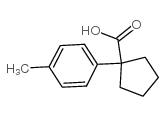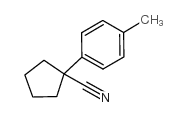80789-75-9
| Name | 1-(p-tolyl)-1-cyclopentanecarboxylic acid |
|---|---|
| Synonyms |
RARECHEM AL BO 1151
1-(p-Tolyl)-1-cyclopentanecarboxylic acid 5GR MFCD00044672 1-(4-METHYLPHENYL)-1-CYCLOPENTANE CARBOXYLIC ACID EINECS 279-556-3 1-(p-Tolyl)-1-cyclopentanecarboxylic 1-p-tolyl-cyclopentanecarboxylic acid 1-(p-Tolyl)-1-cyclopentanecarboxylic acid1-(4-Methylphenyl)-1-cyclopentane carboxylic acid 1-(4-methylphenyl)cyclopentanecarboxylic acid 1-(p-Methylphenyl)cyclopentanecarboxylic acid |
| Density | 1.135 g/cm3 |
|---|---|
| Boiling Point | 355.7ºC at 760 mmHg |
| Melting Point | 181-184ºC |
| Molecular Formula | C13H16O2 |
| Molecular Weight | 204.26500 |
| Flash Point | 165.6ºC |
| Exact Mass | 204.11500 |
| PSA | 37.30000 |
| LogP | 2.89140 |
| Index of Refraction | 1.5180 (estimate) |
Synonym:1-(4-Methylphenyl)-1-cyclopentane carboxylic aci Section 2 - COMPOSITION, INFORMATION ON INGREDIENTS
Risk Phrases: 36/37/38 Section 3 - HAZARDS IDENTIFICATION EMERGENCY OVERVIEW
Irritating to eyes, respiratory system and skin. Potential Health Effects Eye: Causes eye irritation. May cause chemical conjunctivitis. Skin: Causes skin irritation. Ingestion: May cause gastrointestinal irritation with nausea, vomiting and diarrhea. Inhalation: Causes respiratory tract irritation. Can produce delayed pulmonary edema. Chronic: Effects may be delayed. Section 4 - FIRST AID MEASURES Eyes: Immediately flush eyes with plenty of water for at least 15 minutes, occasionally lifting the upper and lower eyelids. Get medical aid. Skin: Get medical aid. Flush skin with plenty of water for at least 15 minutes while removing contaminated clothing and shoes. Wash clothing before reuse. Ingestion: Never give anything by mouth to an unconscious person. Get medical aid. Do NOT induce vomiting. If conscious and alert, rinse mouth and drink 2-4 cupfuls of milk or water. Inhalation: Remove from exposure and move to fresh air immediately. If not breathing, give artificial respiration. If breathing is difficult, give oxygen. Get medical aid. Do NOT use mouth-to-mouth resuscitation. Notes to Physician: Treat symptomatically and supportively. Section 5 - FIRE FIGHTING MEASURES General Information: As in any fire, wear a self-contained breathing apparatus in pressure-demand, MSHA/NIOSH (approved or equivalent), and full protective gear. During a fire, irritating and highly toxic gases may be generated by thermal decomposition or combustion. Extinguishing Media: Use water spray, dry chemical, carbon dioxide, or appropriate foam. Section 6 - ACCIDENTAL RELEASE MEASURES General Information: Use proper personal protective equipment as indicated in Section 8. Spills/Leaks: Sweep up, then place into a suitable container for disposal. Provide ventilation. Section 7 - HANDLING and STORAGE Handling: Wash thoroughly after handling. Remove contaminated clothing and wash before reuse. Avoid contact with eyes, skin, and clothing. Avoid ingestion and inhalation. Use with adequate ventilation. Storage: Store in a tightly closed container. Store in a cool, dry, well-ventilated area away from incompatible substances. Section 8 - EXPOSURE CONTROLS, PERSONAL PROTECTION Engineering Controls: Facilities storing or utilizing this material should be equipped with an eyewash facility and a safety shower. Use adequate ventilation to keep airborne concentrations low. Exposure Limits CAS# 80789-75-9: Personal Protective Equipment Eyes: Wear appropriate protective eyeglasses or chemical safety goggles as described by OSHA's eye and face protection regulations in 29 CFR 1910.133 or European Standard EN166. Skin: Wear appropriate protective gloves to prevent skin exposure. Clothing: Wear appropriate protective clothing to prevent skin exposure. Respirators: A respiratory protection program that meets OSHA's 29 CFR 1910.134 and ANSI Z88.2 requirements or European Standard EN 149 must be followed whenever workplace conditions warrant respirator use. Section 9 - PHYSICAL AND CHEMICAL PROPERTIES Physical State: Solid Color: beige grey Odor: None reported. pH: Not available. Vapor Pressure: Not available. Viscosity: Not available. Boiling Point: Not available. Freezing/Melting Point: 182.00 - 183.00 deg C Autoignition Temperature: Not applicable. Flash Point: Not applicable. Explosion Limits, lower: Not available. Explosion Limits, upper: Not available. Decomposition Temperature: Not available. Solubility in water: Not available. Specific Gravity/Density: Not available. Molecular Formula: C13H16O2 Molecular Weight: 204.27 Section 10 - STABILITY AND REACTIVITY Chemical Stability: Stable at room temperature in closed containers under normal storage and handling conditions. Conditions to Avoid: Incompatible materials, excess heat, strong oxidants. Incompatibilities with Other Materials: Strong oxidizing agents. Hazardous Decomposition Products: Carbon monoxide, irritating and toxic fumes and gases, carbon dioxide. Hazardous Polymerization: Has not been reported. Section 11 - TOXICOLOGICAL INFORMATION RTECS#: CAS# 80789-75-9 unlisted. LD50/LC50: Not available. Carcinogenicity: 1-(p-Tolyl)-1-cyclopentanecarboxylic acid - Not listed by ACGIH, IARC, or NTP. Section 12 - ECOLOGICAL INFORMATION Section 13 - DISPOSAL CONSIDERATIONS Dispose of in a manner consistent with federal, state, and local regulations. Section 14 - TRANSPORT INFORMATION IATA Not regulated as a hazardous material. IMO Not regulated as a hazardous material. RID/ADR Not regulated as a hazardous material. Section 15 - REGULATORY INFORMATION European/International Regulations European Labeling in Accordance with EC Directives Hazard Symbols: XI Risk Phrases: R 36/37/38 Irritating to eyes, respiratory system and skin. Safety Phrases: S 24/25 Avoid contact with skin and eyes. WGK (Water Danger/Protection) CAS# 80789-75-9: No information available. Canada None of the chemicals in this product are listed on the DSL/NDSL list. CAS# 80789-75-9 is not listed on Canada's Ingredient Disclosure List. US FEDERAL TSCA CAS# 80789-75-9 is not listed on the TSCA inventory. It is for research and development use only. SECTION 16 - ADDITIONAL INFORMATION N/A |
| Hazard Codes | Xi: Irritant; |
|---|---|
| Risk Phrases | R36/37/38 |
| Safety Phrases | 24/25 |
|
~55% 
80789-75-9 |
| Literature: Roberts, Donald D.; Arant, Mark E. Journal of Organic Chemistry, 1994 , vol. 59, # 21 p. 6464 - 6469 |
|
~% 
80789-75-9 |
| Literature: Journal of Organic Chemistry, , vol. 59, # 21 p. 6464 - 6469 |
| Precursor 2 | |
|---|---|
| DownStream 1 | |


